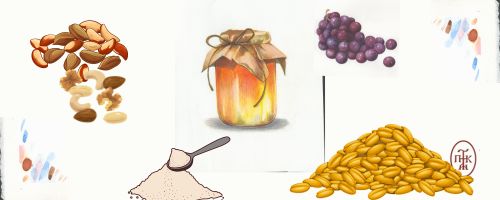
| 4 kg of concentrated must or petimezi, plus ½ kg of water, depending on your preference for sweetness | |
| 700 g of all-purpose flour | |
| 300 g semolina, fine. | |
| 2 teaspoons of crushed mastic | |
| 4 teacups of crushed and roasted walnuts and almonds | |
| 2 teacups or so of crushed and toasted sesame seeds for the garnish. | |
| 6 tablespoons of cinnamon powder | |
| a little sugar or honey optional, depending on how sweet you want it |
| 1. | Bring the must or petimezi to a boil, stirring with a whisk (not a ladle) to prevent sticking. |
| 2. | In a bowl, dissolve the flour and semolina in the water. |
| 3. | Once it starts to boil, add half of the almonds and walnuts with the mastic and then the flour solution slowly, through a sieve, without lumping. |
| 4. | From this moment and in about 5 minutes, it is ready. |
| 5. | When it thickens (thickens) well enough, remove from the heat and serve in shallow individual bowls (or saucers). That way, each spoonful you eat will have more nuts in it. |
| 6. | Then combine the remaining almond-nuts with the sesame and cinnamon and sprinkle over all the bowls. |
| 7. | It can be eaten cold or hot depending on our preferences. |
| 8. | Tip: |
| 9. | Mustalevria comes conceptually from the word must and flour, because in the past our parents and ancestors used to make mustalevria on the day of the production of new wine, which was boiled must fermented with flour. |
| 10. | Today moustalevria is made from petimezi, which is boiled for about 10 hours, must and now tastes sweet with the evaporation of water and is thick. |
| 11. | It is edible, sugar-free, healthy and ideal for children. |
| 12. | It is usually made in August-September but also all year round, when we have petimezi. |
| 13. | It can also be made into a mustard pastel when dried very well in shallow pans. |
| 14. | You can add raisins along with the nuts, if you prefer. |
| 15. | It's important that the mustard doesn't catch while boiling because apart from the smell it will clump, so stir constantly until you take it off the heat. |
| 16. | You can pour the mustard mixture into one or two large baking pans in order to have a thin layer and when it cools down, cut and serve pieces in the shape of your choice (squares, triangles, rhomboids, sticks, etc.). |
| 17. | It can be kept out of the refrigerator (depending on the season) for 2-3 days and for more days in the refrigerator. |
| 18. | It should not be boiled over high heat, because the flour does not have time to cook well. |
